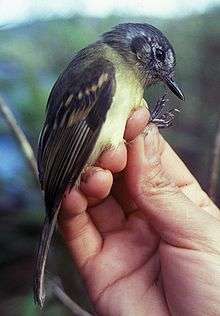Slaty-capped flycatcher
| Slaty-capped flycatcher | |
|---|---|
 | |
| Scientific classification | |
| Kingdom: | Animalia |
| Phylum: | Chordata |
| Class: | Aves |
| Order: | Passeriformes |
| Family: | Tyrannidae |
| Genus: | Leptopogon |
| Species: | L. superciliaris |
| Binomial name | |
| Leptopogon superciliaris (Tschudi, 1844) | |
The slaty-capped flycatcher (Leptopogon superciliaris) is a small passerine bird in the tyrant flycatcher family. It breeds from Costa Rica through Colombia and northern Venezuela to northern Bolivia, Ecuador, and Peru. It also occurs on Trinidad.
This species is found in forests and woodland edges. The nest is a ball lined with fine plant fibres, with a side entrance. It is suspended by a tendril or root and built in a heavily shaded area, such as a rock cleft or under hanging vegetation at the top of a bank. The typical clutch is two white eggs. The chicks fledge about 20 days after hatching.
The adult slaty-capped flycatcher is 14 cm long and weighs 12.6g. The head has a dark grey crown, grey and white face, grey supercilium, and black crescentic ear patch. The upperparts are olive-green and the dusky wings have two yellowish wing bars. The throat is whitish and the breast is greenish yellow shading to yellow on the belly. The long heavy bill is black above and pink-based below. Sexes are similar, but young birds have a more olive crown, weaker face pattern, orange wing bars and paler underparts.
Slaty-capped flycatcher are seen alone or in pairs, perched in the open or catching insects in flight or from foliage. They also frequently eat berries. They have a sharp switch-choo call.
References
- ↑ BirdLife International (2012). "Leptopogon superciliaris". IUCN Red List of Threatened Species. Version 2013.2. International Union for Conservation of Nature. Retrieved 26 November 2013.
| Wikimedia Commons has media related to Leptopogon superciliaris. |
- ffrench, Richard (1991). A Guide to the Birds of Trinidad and Tobago (2nd ed.). Comstock Publishing. ISBN 0-8014-9792-2.
- Hilty, Steven L (2003). Birds of Venezuela. London: Christopher Helm. ISBN 0-7136-6418-5.
- A guide to the birds of Costa Rica by Stiles and Skutch ISBN 0-8014-9600-4
